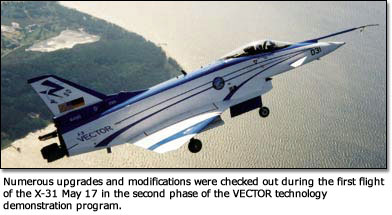| Shorter, slower, better
The X-31 is using thrust vectoring to
change the rules for aircraft carrier landings
BY WILLIAM COLE

 The
U.S. Navy has long dreamed of making carrier landings safer, more operationally
efficient, and less wearing on the structure and aircraft landing gear. The
U.S. Navy has long dreamed of making carrier landings safer, more operationally
efficient, and less wearing on the structure and aircraft landing gear.
The answer may lie in the X-31 thrust-vectoring technology demonstrator.
This aircraft, which recently resumed flights at Naval Air Station Patuxent
River, Md., under the second phase of the VECTOR technology demonstration
program, will be able to land at 150 knots, versus the typical 165 knots,
and at a 20-degree angle of attack, versus the normal 12 degrees.
Should the technology from VECTOR be transferred to fleet aircraft, the
result would be reduced wear and tear on the aircraft, less need to jettison
unused stores and fuel before landing, and less maintenance on carrier
arresting gear and catapults. The landing technology also could lead to
fewer wind-over-deck requirements for aircraft carriers. All this will
greatly increase operational flexibility, life-cycle savings and safety.
Boeing Phantom Works is the U.S. prime contractor for the program.
The VECTOR program name stands for Vectoring Extremely Short Takeoff and
Landing Control Tailless Operation Research. The X-31’s secret lays
in three paddle-like tail vanes that redirect the engine’s exhaust
plume in response to pilot input, and provide lift and control at low
speeds and high angles of attack. The United States Navy’s ultimate
goal for the VECTOR program is to verify that thrust vectoring can be
used for extremely short takeoff and landing.
The X-31 originally was flown under the auspices of the Enhanced Fighter
Maneuverability program during the early 1990s, and the $53 million VECTOR
program is capitalizing on this previous investment. VECTOR is a joint
venture that includes the Navy; Germany’s defense procurement agency;
Boeing Phantom Works; and European Aeronautic, Defence and Space Co.
The first flight of the second phase of the program, May 17, checked out
numerous upgrades and modifications. These included new flight control
software, an auto-throttle system, a belly-mounted video camera and components
of inertial navigation and global positioning systems. The X-31 also carries
EADS’ Flush Air Data System, a nose-mounted sensor package accurate
at all angles of attack.
“The airplane flew nicely and as predicted,” said German Naval
Reserve Cmdr. Rüdiger “Rudy” Knöpfel, who piloted
the first flight of the second phase. “I’m very confident about
the future of the program.”
Jennifer Young, U.S. Navy VECTOR Program Manager, said, “It’s
great to get back in the air. We learned a lot about the airplane and
look forward to getting more data from the ongoing flights.”
Boeing Phantom Works VECTOR program manager Gary Jennings said, “In
this phase, we’ll demonstrate this important technology that could
eventually lead to significant operational and cost benefits for flight
operations aboard aircraft carriers. We have a great airplane, a great
program and a great team.”
About 30 more flights are expected before the second phase concludes late
this summer. The X-31 will fly extremely short takeoff and landing approaches
to a virtual runway at 5,000 feet in the sky, to ensure that the Inertial
Navigation System/Global Positioning System accurately guides the aircraft
with the centimeter accuracy required for such landings. The program will
culminate in extremely short takeoff and landing on a real runway. And
that might hold significance for unmanned systems of the future, said
the Navy.
|